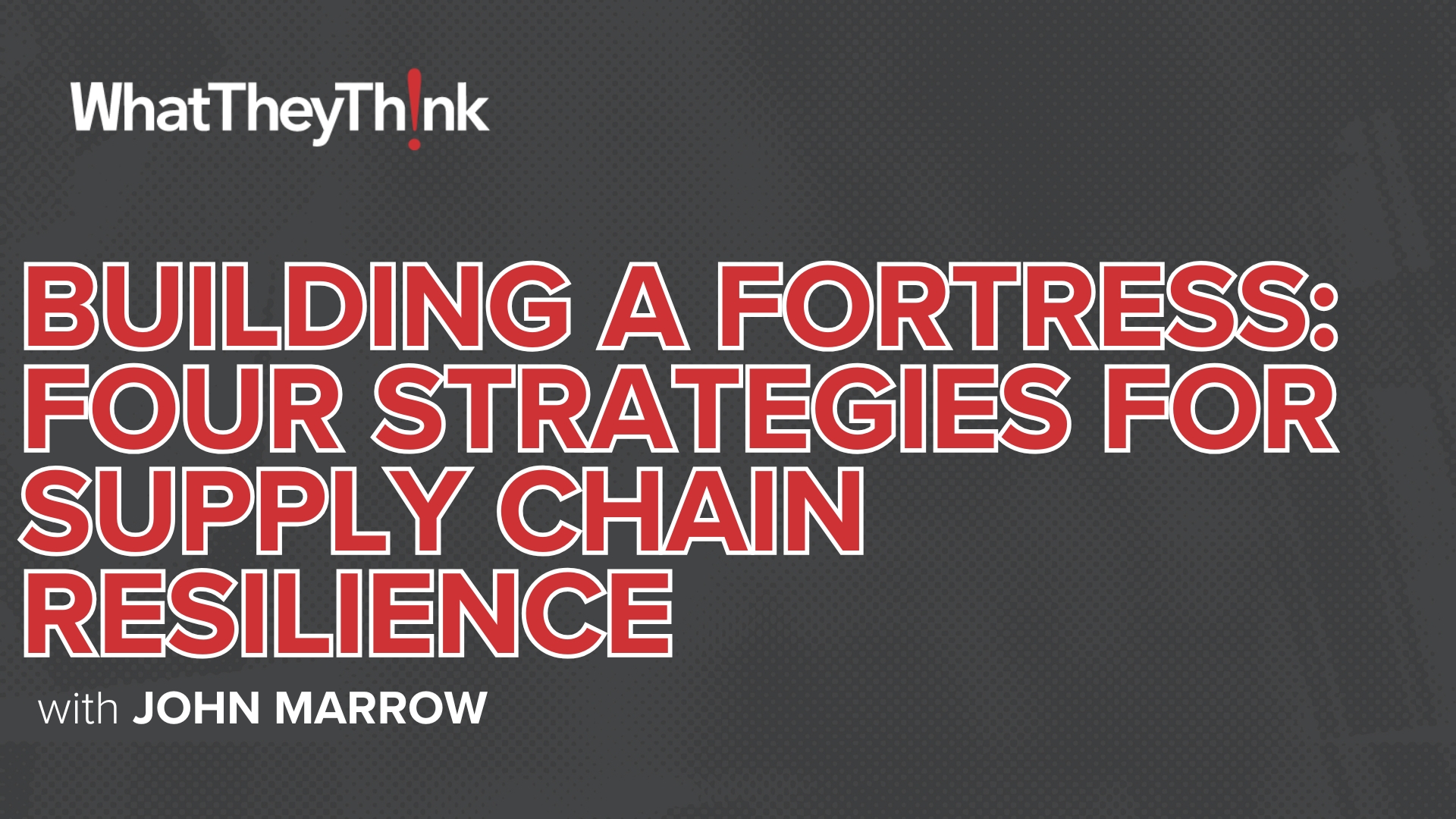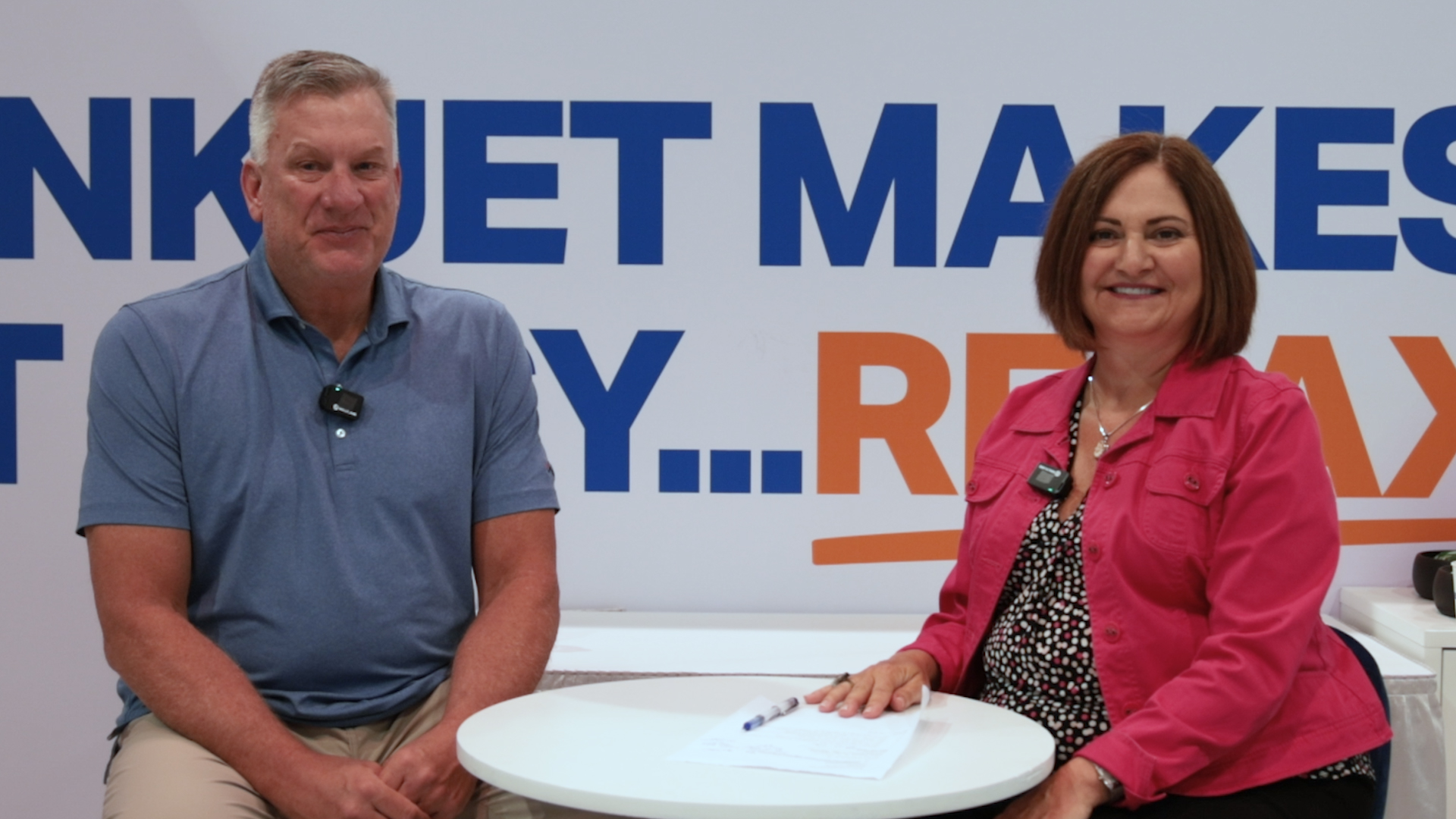Commentary & Analysis
Displaying 3101-3200 of thousands of articles
Insight You Need. Analysis You Trust.
Get the trusted insights you need to understand our evolving industry and emerging trends. Become a Premium Member.
Dresslife Works to Deliver a Magical Ecommerce Experience for Fashion
As consumers look to ecommerce for more and more of their purchasing, the fashion industry has a growing issue with costly returns—largely because items don’t fit as expected. Dresslife works with fashion brands and retailers, enabling them to offer a better customer experience and has launched a mobile app. We spoke with Dresslife’s marketing manager, Yvonne Georgi, to learn more.
Printing’s Labor's Lost?
Overall printing employment dropped -0.7% from March to April 2019 and on a year-over-year basis is down -2.9%. Production employment dropped a tad from March to April, and is down -4.5% from April 2018. Non-production employment was up +0.6% from April 2018 to April 2019.
Around the Web: Textile Reshoring. $50 Typo. Ad Nauseam. Beyond RGB? Salvador Dalí Meets the Marx Brothers. The World’s Smallest Post Service. Parrot-Based Marketing. Also: Hatebeak!
OnPoint named Alabama Manufacturer of the Year. New dress shirts. The origin of the word “dude.” A dark vision of the future of advertising. Will we ever be able to see more colors? The long lost Marx Brothers movie written by Salvador Dalí. Selling whisky with parrots. All that and more in WhatTheyThink’s weekly miscellany.
Direct-to-Garment Printing Landscape Grows Across Commercial and Industrial Sectors
Digital has become a viable method for printing a variety of fabric applications, and the technology is now extending its reach into the direct-to-garment (DTG) market. This article offers a brief discussion about the growth in DTG printing and discusses some key trends for the commercial and industrial printing sectors.
A Conversation About Web-to-Print With Slava Apel, Founder of Amazing Print
If today’s online storefronts and web-to-print workflows don’t look anything like they used to, there’s a reason. The software has advanced leaps and bounds from where it was even a few years ago. This interview with founder and CEO of Amazing Print Tech Slava Apel reflects how the technology is changing...and how it is changing those who use it.
Adobe Continues Enhancement of Photoshop Textile Design Capabilities
Six months ago, we reported on Adobe’s Project Paras, a public beta of an addition to Photoshop CC that made it easier for textile and apparel designers to do their work. We checked in with Mike Scrutton, Director of Print Technology and Strategy for Adobe, to get an update.
How Clean Is Your Print Business Data?
All print business owners want more data about their businesses so they can make better decisions. It isn’t about reporting packages or business intelligence tools—it’s really about how your business generates data on a daily basis.
The De-Evolution of Cenveo—April 2019 M&A Activity
Cenveo spins out more assets, Knepper acquires, MSP converges, and more…
Fujifilm Launches Next-Generation J Press 750S
Last week, Fujifilm held a user event at its experience center outside Chicago to launch the J Press 750S, the company’s third-generation cut-sheet production inkjet press. The event included presentations from Fujifilm executives, a user panel, and a tour of the center featuring Fujifilm’s vast portfolio of inkjet technologies, both small- and wide-format.
Kodak Flexographic Packaging Reborn—Introducing Miraclon
In this age of digital print transformation, what is so exciting about the rebirth of a plate manufacturer? Well, first of all, it is a flexographic plate manufacturer, and second, it was formerly owned by Kodak. With this new life, how will Miraclon leverage their expertise to grow into a market leader?
WhatTheyThink Exclusive—Why EFI Acquired BDR Boya Kimya and What’s Up with EFI BOLT: An Interview with Adele Genoni, EFI Reggiani Vice President and General Manager
On Friday, EFI announced yet another acquisition, this time Turkish company BDR Boya Kimya, a leading manufacturer of reactive inkjet inks for industrial digital textile printing. We spoke with Adele Genoni, EFI Reggiani’s Vice President and General Manager, to get the inside scoop on this acquisition. While we had her on the line, we also asked for an update on EFI BOLT, the world’s fastest digital textile printer.
Around the Web: From Tablets to Tablets. Quantophrenia. Smart Towels. The Pinkest Pink. Email Snail Mail. Oak Gall Ink.
A new history of writing exhibition. Towels that tell you when to wash them. Why the Red Cross loves Dave Brubeck’s “Take Five.” Send a physical letter...by email. Making ink from oak galls. All that and more in WhatTheyThink’s weekly miscellany.
Print Business Challenges: Some Old Cares, Some New Concerns
In Winter 2018/2019, we conducted our annual Print Business Outlook Survey and found that the top challenges for print businesses included some new cares and concerns with some of the old challenges falling by the wayside. Could this reflect a “changing of the guard” of print business management?
2019 Sign and Display Graphics Franchise Review
In WhatTheyThink/Printing News’ Annual Sign and Display Franchise Review, Cary Sherburne takes a look at the major franchises—Alliance Franchise Brands, FASTSIGNS, Signarama, and SpeedPro—as well as the non-franchise Sign Biz network. She analyzes how they fared in the past year, as well as where they see growth opportunities in the future. Franchise center growth across all the networks has been strong, and will likely remain so. What is driving it?
Print China Gains Ground as Asia’s Largest Printing Exhibition
Held every four years since 2007, Print China alternates with China Print and offers a unique focus on Southern China’s printing industry for local and international visitors. This article provides a brief overview of the most recent iteration of the event, which was held in April at the Guangdong Modern International Exhibition Center.
Lesson from the Cracker Jack Box: Let’s Use AR Responsibly
Even as the technology and implementation of augmented reality races forward at blazing speed, many marketers are still stuck in the past. As a result, and as illustrated by my recent experience with the prize in a Cracker Jack box, it hurts the entire industry.
Solve Problems Your Customers Care About
I wish all customers’ top priority was purchasing high-quality print; it isn’t. Your customer’s have upstream problems. The printers who go upstream and solve these problems will be rewarded as manufacturers downstream.
Enabling Sales with the Right Story: “Prerequisites” for Today’s Print Sales
Pat McGrew launches a new series on selling in today’s print environment. In this introductory installment, she identifies some of the “prerequisites” that today’s print sales people need to take with them on any sales call—regardless of what kind of sales method they use.
Idealliance Develops XCMYK Color Space for Inkjet and Digital
Inkjet and digital technology typically have a large color gamut—larger than Idealliance GRACoL and Fogra. This market needed a color space, profile, and dataset so Idealliance created XCMYK.
ISA Sign Expo 2019 Wraps Up in Vegas
Some “quick hits” from the Sign Expo show floor, including the winners of the ISA Innovation Awards, some new product announcements, and more.
Sign Manufacturers—2010–2016
In 2016, there were 5,650 Sign Manufacturing establishments (NAICS 33995). The decline and rise of sign manufacturing over the course of the 2010s reflects the impact of the Great Recession, as well as the recovery and the growth of digital printing into traditional signmaking.
Around the Web: Offline Americans. Touring Greece. Loud Restaurants. Topical Typography.
10% of Americans do not use the Internet. The Comma Queen” tours Greece. The rise of the Post Office—and the decline of dueling. A new app measures the loudness of restaurants. The Presidential candidates’ typography. A requiem for the old Penn Station. All that and more in WhatTheyThink’s weekly miscellany.
Sign Expo 2019 Opens in Las Vegas
Old and new sign production technologies were on display this week in Las Vegas at the 75th Annual ISA Sign Expo and, as an additional indication of how the disparate pars of the printing industry are concverging, ISA announced that as of next year the Sign Expo will colocate with Impressions Expo, formerly the Imprinted Sportswear Show.
High-Value Digital Applications: New Opportunities on the Horizon
High-value applications and the digital devices that are required to produce them are becoming increasingly prevalent. These solutions are now moving downstream and have become accessible to medium-sized and even small print service providers. This article explores how high-value applications are coming to represent the fast track to the digital transformation.
HP Makes First Entry into Digital Textile Printing
Back in early 2018, we spoke with Mike Horsten, then Business Manager for Large Format Professional EMEA at HP, about HP’s potential plans for entering the digital textile printing market. Now, more than a year later, HP has made its first announcements, launching the HP Stitch series of textile printers. The company held a media briefing to discuss its strategy.
A Culture of Accountability to Learning in Your Print Business
Learning is the experience of trying to do something without parental supervision. It is not watching a trainer do something and shaking your head that you understand. Holding your people accountable for learning activities is the most important part of improving user adoption of new tools in your print business.
Survey: Does Color Variation Matter as Much as We Think?
Heidi Tolliver-Walker summarizes Eddy Hagen’s recent study on the impact of product packaging damage and color variation on consumer purchases. Hagen’s surveys always challenge our assumptions, and this one is no different. The conclusion? Color variation isn’t as important to consumers as it is to the rest of us.
Embellishments: What’s Old Is New Again and Still Adds Value!—Part 2
Embellishment has been a function of print production for as long as there has been printing. In fact, it almost goes back to the beginning of the writing of documents. There is no doubt that embellishment does add value to the printed product. Especially with the more recent introduction of digital embellishment technologies designed to complement digital printing. Now that embellishments have finally begun to capture market awareness, new developments are happening all the time. In part 2 of this series, David Zwang will look at new mainstream technologies that add embellishments and value to print and packaging production.
Signs.com and Ferrari Color: The Inside Story
The acquisition of Ferrari Color by Signs.com caught our attention. Senior Editor Cary Sherburne spoke with Signs.com cofounder and chief operating officer Nelson James to get the inside story.
Technology Evolution Supports New Priorities in Print Signage
The latest research from Smithers Pira identifies five key trends underpinning the shifting dynamics of demand and profitability in the market for printed signage: increasing automation, soft signage, the changing retail landscape, the evolution of Asian retail, and competition from digital signage.
Tailored Industry Revitalizing Knitwear Manufacturing in Brooklyn
Up until about 25 years ago, knitwear manufacturing was a big deal in Brooklyn. But since then, much of it has moved offshore. Tailored Industry is looking to revitalize knitwear manufacturing in Brooklyn using proprietary on-demand software and 3D full-garment knitting technology.
February 2019 Printing Shipments: Starting the Year Off on the Right Foot
Printing shipments for February 2019 came in at $6.08 billion. In keeping with the industry’s seasonality, it’s down from January, but so far 2019 shipments are higher than 2018’s.
Around the Web: Mixed Reality Retailers. Heavy Metal Knitting. Recycled Sneakers. 3D Heart. Lego Printing Press. Changing Music Formats. A Netflix Magazine. Mad Libs Sci-Fi Plot Generator.
The first Heavy Metal Knitting World Championships. Running shoes that can be recycled. A 3D-printed human heart. Danger! Facebook is launching a voice assistant! Run! Cursive handwriting is coming back. Netflix is producing a magazine. “Balloon-related incidents.” All that and more in WhatTheyThink’s weekly miscellany.
Control Waste to Improve Your Bottom Line
Although today’s printers understand that they must automate their print operations, a bias seems to exist between the potential benefits of investing in equipment vs. software. This article cites recent research from Keypoint Intelligence – InfoTrends to highlight the importance of controlling waste. By implementing processes, procedures, and software, printers can accurately measure waste and improve their quality control.
The Proven Path to High Profits: Sell as Much as You Can Produce for as Much as the Customers Will Pay
The key to effective pricing (aka profitability) is not just understanding costs, but understanding the market for print and what customers are willing to pay. Tailoring estimating and quoting to individual customers, or groups of customers, can help maximize the contribution from current customers, and potentially win customers who may have been hesitant to do business with you.
Pattern Recognition as a Path to Print Business Efficiency
Your print business is rich with patterns. By looking at patterns we can find ways to codify those patterns into processes that make us more efficient. You need real human processing for your business—free this up by taking the recurring stuff off their plates.
Four Millennials and One Gen Z Dish on QR Codes
I got four Millennials and one Gen Z in a room and peppered them with questions about QR Codes. Did they use them? Why or why not? If they didn’t, what was holding them back? What I discovered is that, in the mind of these generations, if it ain’t broke, why fix it?
When Mayhem Calls—Part 4
Planning for a catastrophe is something that every business owner knows they should do. At some point there is usually some effort applied, a plan developed, filed away, and the box checked that there is a business continuity/disaster recovery plan on file. It makes the auditors happy! But, when mayhem actually calls, will your plan actuallywork? In part four of this series, Pat McGrew offers tips on how to design and execute a continuity plan.
Exclusive Interview: EFI CEO Bill Muir and CFO Marc Olin Discuss Recently Announced Acquisition by Siris Capital Group
A press release from EFI Monday morning caught the industry by surprise. The company announced a definitive agreement to be acquired by an affiliate of Siris Capital Group LLC. Senior Editor Cary Sherburne spoke with CEO Bill Muir and CFO Marc Olin to get some background on the announcement.
SPESA President Explains Association’s Value to the Sewn Products Industry
Are you a supplier to the sewn products industry? If so, are you a member of SPESA? And if you are not, this article from Senior Editor Cary Sherburne lays out why you should be. SPESA’s President Michael McDonald shares his thoughts on the association’s role in promoting and supporting the sewn products industry from the supplier’s perspective.
Outdoor Advertising Establishments—2010–2016
In 2016, there were 2,556 establishments classified as Outdoor Advertising (NAICS 54185). In 2010, NAICS 54185 comprised 2,378 establishments—but note that the Census Bureau changed the name of this category in 2012.
Around the Web: Behind the Seams. Threading the Needle. Imaging the Unimagable. A Good Week for Type. Wikienigma. I, Author. Scamming the Scammer.
The current state of the US textile industry. Ironic commemorative stamps. Making a giant paper dragon. Photographing a black hole. A font of typography news. An encyclopedia of unknowns. Robot-penned books. A screenwriter toys with a Facebook Messenger scammer. All that and more in WhatTheyThink’s weekly miscellany.
Xeikon in Packaging: Ramping Up, Branching Out
The 2019 Xeikon Café event, which took place in late March, attracted 1,000+ visitors from about 250 companies. This article provides a brief overview of Xeikon’s recent progress while also discussing the effects of its annual event.
Production Inkjet: It’s Not Just About the Technology Anymore
Canon Solutions America President Peter Kowalczuk and Production Print Solutions Executive Vice President Francis McMahon talk to WhatTheyThink/Printing News about the company’s new emphasis on the services part of the organization and how today’s production inkjet vendors are tasked with not just offering top-of-the-line technology, but playing a more consultative role in helping customers with business development.
It’s Not Just Birds That Migrate—Printers Do, Too
According to a new survey, printers are doing more than adding new products and services. They are migrating into fundamentally new lines of business...and doing it in large numbers.
Workflow Automation and Standard Operating Procedures
Automation starts with an understanding of the business process and how it’s done “manually.” Documenting this business process is called a “standard operating procedure” which is where you can begin your journey to some level of automation.
Annual Print Franchise Review
In WhatTheyThink/Printing News’ Annual Franchise Review, Cary Sherburne takes a look at how the five major print franchises fared in the past year—and looks back at the last decade to see how franchises were tracking compared to commercial print and draws some conclusions about the value of franchise networks vs. an independent small commercial printing firm operating on its own.
Embellishments: What’s Old Is New Again and Still Adds Value!—Part 1
Embellishment has been a function of print production for as long as there has been printing. In fact, it almost goes back to the beginning of the writing of documents. There is no doubt that embellishment does add value to the printed product. Especially with the more recent introduction of digital embellishment technologies, designed to complement digital printing technologies. New developments in digital embellishment are happening all the time now that it has finally begun to capture market awareness. In part one of this two-part feature, David Zwang will look at the added value and long history of embellishments.
So Many Uses for Cotton! Who Knew?
At TechTextil North America, Senior Editor Cary Sherburne stopped by the Cotton, Inc., booth to learn what’s new with this staple fiber (pardon the pun) and was amazed at all the uses cotton is being put to these days. It’s not just for T-shirts anymore!
CJK Group Opens Next Chapter with Loan-to-Own Strategy—March 2019 M&A Activity
Thomson-Shore under the Gavel, Salem One and Envision3 Acquire Mailing Services, and more…
Windigo Signs Takes Soft Signage to the Next Level
Printed textiles are rapidly replacing vinyl and rigid materials for signage, and Tempe, Ariz.’s Next Level Signs has leapt into so-called “soft signage.” Founder Mark Baldwin has launched a sister company Windigo Signs to offer a robust, custom-made, and weather-resistant alternative for outdoor soft signage mounting.
Business Conditions: Up in 2018, Optimism High for 2019
In Winter 2018/2019, we conducted our annual Print Business Outlook Survey and found that business in 2018 was perceived by survey respondents as overall pretty good: 42% said that revenues had increased by six percent or more compared to 2017.
Around the Web: iPhone Airbags (no, not the users). April Fool’s Folly. In Praise of Jet Lag. 3D Color Matching. Screen Sharing Horror Stories. No eBooks for You. One Ruler to Rule Them All.
April Fool’s Day: some cautionary tales. Pantone’s color matching for 3D printing. Be careful when you share your screen. Repossessing eBooks. Gin and tonic toothpaste. All that and more in WhatTheyThink’s weekly miscellany.
On the Edge: DSCOOP Moves
DSCOOP is a mature show, so its organizers are continually seeking ways to innovate, educate, and inspire. This article provides some key highlights from this year’s event and the DSCOOP Edge agenda.
Secure Printing Is an Industry-Wide Challenge
Security printing is no longer about just about foiling counterfeiters. From packaging to book printers to retail to businesses that serve the architecture, engineering, and construction (AEC) industry, along with financial printers, protection of files and products must be considered. There is a need for a broader definition of what security printing means and for a greater number of print providers to think of themselves as “security printers.” Maybe instead it should be called “secure printing.”
“Alexa, Tell Me About Voice Technology”: A Conversation with Bradley Metrock of Score Publishing
Voice technology is appearing in more and more places—and is starting to become relevant to printing and publishing. WhatTheyThink talks to Bradley Metrock, CEO of Score Publishing, producer of the VoiceFirst Events portfolio which includes The Alexa Conference, the Voice of the Car Summit, and Digital Book World, about the current and future state of voice technology.
ISA Sign Expo Heads Back to Vegas
ISA Sign Expo 2019 heads to Las Vegas later this month, with four days of educational sessions and its continuously expanding exhibition floor. We spoke with Brandon Hensley, ISA’s Chief Operating Officer, and Iain Mackenzie, ISA’s VP of Meetings & Events, about what’s new this year.
Sustainability Initiatives to Impact Growing Functional and Barrier Coatings Market, According to Smithers Pira
Functional and barrier coatings are extremely important in the production of paper and board packaging as they provide a protective barrier against water and water vapor, oil and grease, and oxygen and aromas. The barrier coatings industry faces ongoing change in preferred material usage as governments and brands increasingly look for alternatives to plastic packaging for sustainability and recycling purposes. A new report from Smithers Pira details these new sustainability initiatives.
When Mayhem Calls: Part Three
Business as usual is great...when business is usual. But what happens when disaster or some other disruption hits the shop? It can be a business killer if it prevents execution of contracted customer work. Do you have an emergency plan? In Part Three of this series, Pat McGrew offers tips on setting up contingency plans for when mayhem calls.
Early Express Rocks with Direct Mail Retargeting
Direct mail retargeting used to be a new and untested technique. Today, an increasing number of PSPs are offering it, and the results are pouring in. Here are two terrific examples from Early Express.
Unique.Fashion Provides Tools, Community for Designers
The Fashion Institute of Technology and OnPoint Manufacturing yesterday announced a new development in fashion design that will enable more entrepreneurism to occur in this market. Unique.Fashion is a unique web portal for designers and buyers that is set to transform how fashion is marketed and produced. Senior Editor Cary Sherburne spoke with OnPoint Chairman Kirby Best to learn more.
PR Establishments—2010–2016
In 2010, there were 8,219 establishments classified as PR Agencies. By 2016, there had been a net gain of +3.2%.
Around the Web: Inside the NYT Printing Plant. Semantic Satiation. NYC’s LED Barge. The Infinite CVS Receipt. Rebuild Your Business. Are App Users Happy? “Harvesting Garfields.”
“The craft, precision, and unexpected beauty of the newspaper printing process.” Rebirth of a paper mill. Keyless in New York. The 14th-Century Mappa Mundi. “Alien”: The Play. Garfield phones storm the beaches. All that and more in WhatTheyThink’s weekly miscellany.
Is Your Print Production Lifted by a Platform?
The first platforms appeared over four years ago and have steadily increased their performance, functionality, and partnerships over time. This article explores the characteristics of true print workflow platforms and discusses how platforms can benefit print production.
Buying Web-to-Print Software Under Duress
Your customers want convenience. Printers who prioritize around making it easy to do business with their customers will differentiate themselves. Don’t wait until your best customers demand online ordering and self-service access to the business they do with you—do it proactively and strategically instead of under duress.
Do You Practice This Art of Top Print Executives?
There is a trait that top executives of growing print companies share. It’s the art of being still and listening. Here are three examples of how top print executives do this in their own way...and why.
There Are Opportunities in Labels and Packaging—But Where Do You Start?
Whether you are already a converter or are a print service provider looking at expanding your product and services portfolio, it is important to develop a long-term strategy in order to capture your share of the changing and developing market. In this new series, David Zwang takes a deep dive into the opportunities, changes, and challenges that you need to focus on in Labels and Packaging.
Graphene in Action: The Kyorene Story
We recently wrote about graphene as a miracle product. At TechTextil 2019, Senior Editor Cary Sherburne was able to see graphene in action, courtesy of Kyorene. In this story, she speaks with Matt Reid, the company’s director of sales, about current and future strategies of the business, and how he expects to see graphene impact the textiles market.
Printing Industry Profits: Urban Sprawl in the Tale of Two Cities
Overall, annualized printing industry profits for Q4 2018 were $3.66 billion—not a massive gain from Q3 but a gain nonetheless (we’ll take it). It also appears that the “tale of two cities” trend is—at least temporarily—on hold.
Around the Web: State Books. Speaking of Food. New Words in the OED. Gen Z and Sustainable Streetwear. “The Scream” Reconsidered. Lost in MySpace. In Praise of Newsletters.
Which book was the most popular in your state in 2018? Did early humans' dietary changes affect speech? What new words did the OED add to the English lexicon? How are Gen Zers’ sustainable buying preferences driving new apparel products? Is Munch’s “Scream” guy actually screaming? People still use MySpace? Have you heard Vienna’s Vegetable Orchestra? All that and more in WhatTheyThink’s weekly miscellany.
The Print Management Market: Where Is it Growing and How Big Can it Get?
Through consolidated purchasing, print management providers offer cost savings and upgraded efficiencies that in-plants struggle to match, as well as a wider array of products, applications, and expertise than a single print manufacturer can manage. This article provides an overview of the print management market and discusses key opportunities for growth.
Why Do You Need a Print MIS Administrator?
Software is like a press; it needs to be staffed. Software is like a press; it needs to be maintained. Software is like your business; it needs to keep evolving. Your most important piece of software is your Print MIS—dedicate the tasks of your Print MIS to one individual.
Forget Passalongs—What If Print Is “Shared” Instead?
Traditionally, when people share a printed piece they have received with others, we use the term “pass-along.” But what if we want to think about print in a more current context? What if we started using the term “shared” instead?” In other words, what if we started thinking about print the same way we think about digital channels?
A Legal Alien in New York
Our European correspondent reports from the US, and reminds us that small cultural differences can affect how we communicate with each other.
Is Personalization Important to Labels and Packaging?
We have all seen the studies and even experienced first-hand the value of personalization in direct mail and other forms of communication. But what about the value of personalization in products and packaging? There are a lot of projections into what the market value “could” be, but how do you take advantage of that?
Retail Expert Shares Thoughts on Digital Transformation
While the retail and apparel industries are moving to more digital technologies and processes, many observers still believe we are in the infancy of the analog-to-digital transformation the industry will ultimately need to undergo. Senior Editor Cary Sherburne recently spoke to a digital advocate to gain insight into the industry’s progress. Kelly Price, Director of Business Development for consulting firm ArcherGrey, made some interesting observations.
Around the Web: Tome Readers. Apple iArmor? Laptop Typewriter. Tiny Tomes. Sappy Sentiment. Me+Moo.
Print books remain more popular than digital formats. Save the date: WTIN’s digital textile webinar. The first laptop typewriter. Why did people stop wearing hats? An exhibition of really tiny books. Unlucky in love? Try writing to a tree. (No, not D. Eadward Tree.) All that and more in WhatTheyThink’s weekly miscellany.
Advertising Agency Establishments—2010–2016
In 2010, there were 13,248 establishments classified as Advertising Agencies. By 2016, there had been a net gain of +1.0%, the ups and downs reflecting the changing role of the ad agency.
What Hololens 2 Means for PSPs
Last month, Microsoft announced the introduction of its Hololens 2 mixed reality headset. This article explores what the upcoming product could mean to the print market, while grounding print service providers’ expectations.
Give Your Employees Better Tools
New software tools are often rejected because the humans feel like their jobs are being replaced by computers. Software does math better, faster, and more accurately than humans—that is not debatable. But new tools augment brainpower—not replace it.
Do You Know the Psychology of Discounts and Deals?
Part of being a marketing services provider is helping your clients with their marketing, and this goes beyond integrating marketing channels and improving databases. It includes selecting and tweaking the right offers, too. Studies on this topic provide fascinating insight into the psychology of discounts and deals.
When Mayhem Calls: Part Two
Business as usual is great...when business is usual. But what happens when disaster or some other disruption hits the shop? It can be a business killer if it prevents execution of contracted customer work. Do you have an emergency plan? In part two of this new series, Pat McGrew offers tips on planning for the worst and how to manage customer expectations.
TechTextil 2019 Generates Inspiration, Excitement
Techtextil North America was a success by any measure. The show, which moved from Chicago to Raleigh N.C., drew more than 3,000 textile and apparel professionals and included an impressive symposium program. Cary Sherburne provides a quick summary.
Printing Outlook 2019—Has the Industry Turned a Corner?
WhatTheyThink’s annual printing industry outlook report, including the results of our Winter 2018–2019 Business Outlook survey, is now available in our Report Store. This article offers some of the top-level results from that survey.
December 2018 Printing Shipments: Ending 2018 on a High(ish) Note
Printing shipments for December 2018 came in at $6.40 billion. In keeping with the industry’s new seasonality, that’s down from November, but higher than December 2017—but just barely.
Around the Web: Forensic Fashion. Grayscale iPhone Display. 3D-Printed Orthotics. Hypnotic Password Retrieval. Independent Bookstore Owners Help Out One of Their Own.
Forensic garment analysts. Fast fashion and the environment. A toast matching system. John Steinbeck sends Marilyn Monroe a fan letter...sort of. Death of a robot. All that and more in WhatTheyThink’s weekly miscellany.
Platinum Equity Likes Print—February 2019 M&A Activity
Multi-Color Corporation taken private, McCormick Armstrong joins list of defunct web offset printers, trade-only printers trade hands, and more…
InPrint USA to Showcase the Latest Industrial Printing Opportunities
InPrint USA heads to Louisville, Ky., to showcase the latest opportunities for commercial printers in the fast-growing area(s) of industrial printing. Richard Romano offers a preview, and talks with InPrint co-founder Frazer Chesterman about the show and industrial printing.
FiberForce Partners with Pantone to Bring Professional Color to 3D Printing Filaments
Last month, Pantone entered into an agreement with FiberForce Italy to bring Pantone colors into the world of 3D printing. Although color has been available in 3D printing filaments and powders for some time, there has been no standard way to ensure users achieve the color they are truly looking for. All of that changes with this partnership. Senior Editor Cary Sherburne spoke with both Pantone and FiberForce to learn more.
Automation on Display at Hunkeler Innovationdays: Watch Out for the Robot!
During odd-numbered years, the Hunkeler-sponsored Innovationdays event in Luzern, Switzerland, features finishing solutions for the transactional, commercial graphic arts, and book industries. This article provides a brief overview of the announcements that brought the theme of automation to the forefront at this year’s event.
Is the Offer One of Your Database Variables?
To move the needle on direct mail responses, your customers may change up their copy, their images, or their list. But what about their offers? A new Bed Bath & Beyond mailer raises an interesting question.
The Importance of Uninterrupted Time in a Print Business
Your print business is being invaded by software tools. These tools require a level of thinking/concentration that requires blocks of uninterrupted time for your employees. Without this uninterrupted time, your software will remain grossly underutilized and lacking measurable ROI.
When Mayhem Calls: Part One
Business as usual is great...when business is usual. But what happens when disaster or some other disruption hits the shop? It can be a business killer if it prevents execution of contracted customer work. Do you have an emergency plan? In part one of this new series, Pat McGrew offers tips on planning for the worst.
World on the Windows: The Changing Face of Window Graphics
Window graphics are a growing subset of wide-format printing, and are popping up in more and more locations, both public and private, and new films and materials are making window graphics more versatile and eye-catching than ever. Printing is the easy part; it’s installation that can cause problems, and eat into your profitability. Here are some dos and don’t for working with window graphics.
Roland DGA Enters Direct to Garment Market
Senior Editor Cary Sherburne spoke with Roland DGA President Andrew Oransky about the company’s entry into the direct-to-garment (DTG) market as well as its overall go-to-market strategy and its future plans relative to direct-to-textile printing.
Advertising and Related Establishments—2010–2016
In 2010, there were 38,335 establishments classified as Advertising, Public Relations, and Related Services. By 2016, there had been a net loss of -1.2%. This is a very broad industry classification, comprising a disparate bunch of business types, each of which has its own unique dynamics.
Around the Web: Traveling Texts. Fit to Be Untied. Kodak Film Is Da Bomb. Uber Economics. Office Space Turns 20. Paper Fold-Away Bed. Lunar Library. Bridge of Size.
Getting a text from sender to receiver. The Internet of shoes. Nuclear testing and Kodak film. An oral history of “Office Space.” In praise of standards. Retrieving DNA from old books. Digitize yourself for the perfect fit. All that and more in WhatTheyThink’s weekly miscellany.
HP Highlights New Business Opportunities at the 2019 Indigo VIP Event
HP Indigo hosted its annual Global VIP event in Tel Aviv, Israel, from February 11–14, 2019. This year’s event drew over 650 visitors to HP Indigo’s headquarters, production, and Research & Development sites to learn about the company’s latest offerings. The event highlighted the latest devices in HP’s digital press lineup and also discussed business opportunities for growing applications.
Sustainability and E-Commerce Driving Growth in Luxury Packaging
The demand for luxury packaging across the world continues to increase. Sustainability, e-commerce, and material trends are driving the luxury packaging market and will continue to shape it over the next five years. A new Smithers Pira report details these key products, materials, and market trends.
Here Comes the Flood—Going Live with Print Software
Think of your go-live date for your Print MIS as a flood. Prepare for it by training everyone how to create sandbags and then monitoring that everyone actually applied the learning and figured out how to do their jobs in the new system BEFORE go-live.
- Questions to ask about inkjet for corrugated packaging
- Can Chinese OEMs challenge Western manufacturers?
- The #1 Question When Selling Inkjet
- Integrator perspective on Konica Minolta printheads
- Surfing the Waves of Inkjet
- Kyocera Nixka talks inkjet integration trends
- B2B Customer Tours
- Keeping Inkjet Tickled Pink
© 2024 WhatTheyThink. All Rights Reserved.














